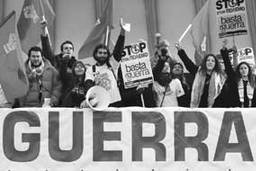
The way you usually read about globalization protests in the mediaeven the progressive mediathere are good protesters (labor unions or NGOs like Public Citizen and Global Exchange) and then there are bad protestersscary, window-smashing anarchist kids whose senseless violence only acts to bring down police repression and undercut the good protesters message. This was always a ridiculous dichotomy, but the January protests in New York surrounding the World Economic Forum ought to lay this myth to rest.
The World Economic Forum, essentially a dining club for the worlds ruling class, had been held every year for decades in the resort town of Davos, Switzerland; that is, until a concerted campaign of direct action made things so unpleasant for them that they were, for all practical purposes, driven out.
So after September 11, the World Economic Forum declared, for this year at least, that they were relocating to the Waldorf-Astoria hotel in Midtown Manhattan. It seemed a perfect formula: New York had the largest police force in the entire world, not to mention one already made heroes in the media. A single shard of broken glass would be enough to give the pundits an excuse to frame the global justice movement as another al-Qaeda come to terrorize an already traumatized community.
Certainly, the unions and NGOs were terrified; one by one, they effectively dropped out. All that remained were the anarchists, students and direct action people, who were left with the responsibility ofin a matter of weeksputting together a nationwide mobilization effort, organizing housing, press conferences and seminars, and even applying for a police permit for a legal march (something none of us had ever done before, but which had to be done if a safe space was to be provided for ordinary citizens who did not wish to risk arrest). This was all done with no funding, no real budget, no professional organizers and no leadership structure.
And it worked. In that sense, at least, it was a magnificent success. This is what the direct action movement is ultimately about: reinventing democracy. Far from lacking an ideology, those new forms of radically decentralized direct democracy are its ideology. If nothing else, the bad protesters have managed to prove that they can do anything the (hierarchical) NGOs or unions can, probably much better.
The hardest of the hard core showed upeveryone from the notorious Eugene anarchists to the Urban Guerrilla Division of the Earth Liberation Front, to groups like the Divas for Democracy and the Tute Neri (Black Overalls). Not only did they respect the mood of the city, they filled it with samba bands, tango dancers, giant puppets of the Statue of Liberty and Ken Lay, and chorus lines of Radical Rockettes.
If anything, they were victims of their own success: When something like 20,000 people magically appeared for the start of the march, the organizers hardly knew what to do with them. But alas, we were not only victims of success. We were also victims of the very logic of our compromise with powerand many of us will not forget this.
Anarchy and direct action are not about transgressing laws simply for the sake of it, but ultimately about creating spaces that can stand outside of power, autonomous zones in which one can begin experimenting with things like direct democracy. Its about a vision for what a truly free society might look like. But in order to do this, one must transgress the law. At least, this is what we discovered as soon as anyone applied for a permit. The moment you start submitting to the logic of the state, everything changes.
Organizers ended up submitting themselves entirely to the whims of the police, who predictably broke every agreement theyd made and began arbitrarily stopping, randomly attacking, delaying and generally harassing the marchers. By the time they reached the depressing, barricaded protest pens two blocks from the Waldorf, 20,000 people had dwindled to 2,000, and CNN could dutifully report 2,000 protest in front of Waldorf without even broaching the question of why 90 percent of the marchers had dropped out before they even got thereor, in fact, that the 90 percent had been there at all.
Nightline had taped an elaborate segment which, for once, actually would have discussed the central issues of the globalization movement. But producers cancelled the show because of the lack of violence in the newseven after police pre-emptively swept up 150 activists the next day for the crime of walking down the street. The prisoners were held for days, and as they emerged from jail, nursing broken fingers and black eyes, almost all had exactly the same reaction: We tried being nice. Now we know where that gets us.
The World Economic Forum, essentially a dining club for the worlds ruling class, had been held every year for decades in the resort town of Davos, Switzerland; that is, until a concerted campaign of direct action made things so unpleasant for them that they were, for all practical purposes, driven out.
So after September 11, the World Economic Forum declared, for this year at least, that they were relocating to the Waldorf-Astoria hotel in Midtown Manhattan. It seemed a perfect formula: New York had the largest police force in the entire world, not to mention one already made heroes in the media. A single shard of broken glass would be enough to give the pundits an excuse to frame the global justice movement as another al-Qaeda come to terrorize an already traumatized community.
Certainly, the unions and NGOs were terrified; one by one, they effectively dropped out. All that remained were the anarchists, students and direct action people, who were left with the responsibility ofin a matter of weeksputting together a nationwide mobilization effort, organizing housing, press conferences and seminars, and even applying for a police permit for a legal march (something none of us had ever done before, but which had to be done if a safe space was to be provided for ordinary citizens who did not wish to risk arrest). This was all done with no funding, no real budget, no professional organizers and no leadership structure.
And it worked. In that sense, at least, it was a magnificent success. This is what the direct action movement is ultimately about: reinventing democracy. Far from lacking an ideology, those new forms of radically decentralized direct democracy are its ideology. If nothing else, the bad protesters have managed to prove that they can do anything the (hierarchical) NGOs or unions can, probably much better.
The hardest of the hard core showed upeveryone from the notorious Eugene anarchists to the Urban Guerrilla Division of the Earth Liberation Front, to groups like the Divas for Democracy and the Tute Neri (Black Overalls). Not only did they respect the mood of the city, they filled it with samba bands, tango dancers, giant puppets of the Statue of Liberty and Ken Lay, and chorus lines of Radical Rockettes.
If anything, they were victims of their own success: When something like 20,000 people magically appeared for the start of the march, the organizers hardly knew what to do with them. But alas, we were not only victims of success. We were also victims of the very logic of our compromise with powerand many of us will not forget this.
Anarchy and direct action are not about transgressing laws simply for the sake of it, but ultimately about creating spaces that can stand outside of power, autonomous zones in which one can begin experimenting with things like direct democracy. Its about a vision for what a truly free society might look like. But in order to do this, one must transgress the law. At least, this is what we discovered as soon as anyone applied for a permit. The moment you start submitting to the logic of the state, everything changes.
Organizers ended up submitting themselves entirely to the whims of the police, who predictably broke every agreement theyd made and began arbitrarily stopping, randomly attacking, delaying and generally harassing the marchers. By the time they reached the depressing, barricaded protest pens two blocks from the Waldorf, 20,000 people had dwindled to 2,000, and CNN could dutifully report 2,000 protest in front of Waldorf without even broaching the question of why 90 percent of the marchers had dropped out before they even got thereor, in fact, that the 90 percent had been there at all.
Nightline had taped an elaborate segment which, for once, actually would have discussed the central issues of the globalization movement. But producers cancelled the show because of the lack of violence in the newseven after police pre-emptively swept up 150 activists the next day for the crime of walking down the street. The prisoners were held for days, and as they emerged from jail, nursing broken fingers and black eyes, almost all had exactly the same reaction: We tried being nice. Now we know where that gets us.
David Graeber is a professor of anthropology at Yale University and author of The False Coin of Our Own Dreams: Toward an Anthropological Theory of Value. A contributing editor of In These Times, he is currently working with the Direct Action Network and other activist groups.







